Analyzing the Impact of Supply Side Policies on Business Economics
VerifiedAdded on 2020/01/28
|15
|3840
|97
Essay
AI Summary
This essay delves into the realm of supply-side policies, crucial micro-economic strategies aimed at enhancing the efficiency and productivity of markets, industries, and firms, thereby fostering economic growth. The analysis encompasses government initiatives designed to improve the quality and quantity of the four factors of production. The essay examines various measures, including tax incentives, labor market reforms, and investments in human capital development. It explores the impact of supply-side policies on reducing unemployment, promoting competition, and improving the performance of firms through deregulation and privatization. Furthermore, the essay contrasts supply-side policies with fiscal and monetary policies, while also highlighting relevant economic theories such as Keynesian, endogenous growth, and exogenous growth theories. The benefits of supply-side policies, such as reducing inflationary pressure and promoting employment, are discussed. The essay underscores the importance of government intervention and the role of supply-side policies in achieving stable prices, full employment, sustainable growth, and a favorable balance of payments.
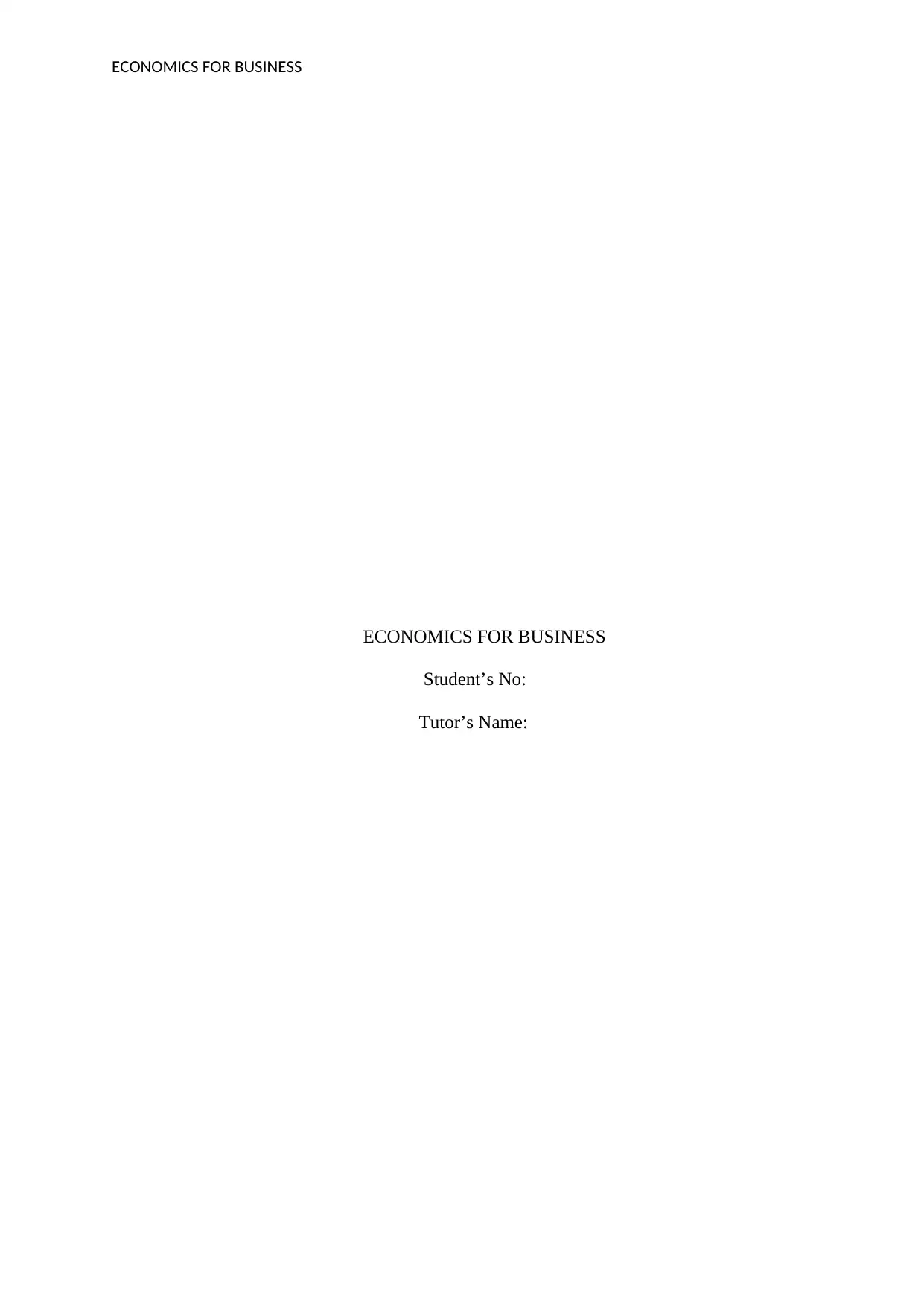
ECONOMICS FOR BUSINESS
ECONOMICS FOR BUSINESS
Student’s No:
Tutor’s Name:
ECONOMICS FOR BUSINESS
Student’s No:
Tutor’s Name:
Paraphrase This Document
Need a fresh take? Get an instant paraphrase of this document with our AI Paraphraser
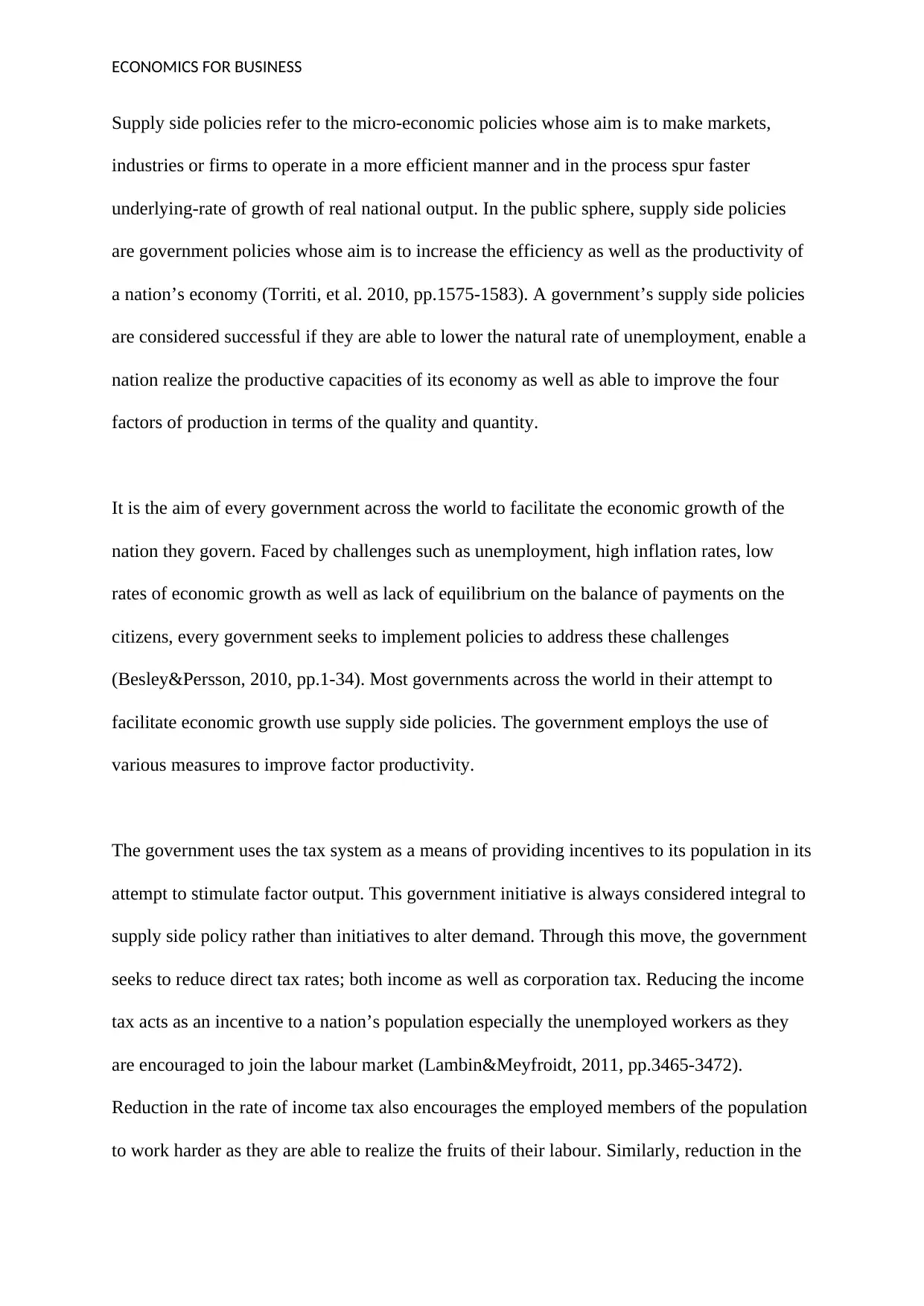
ECONOMICS FOR BUSINESS
Supply side policies refer to the micro-economic policies whose aim is to make markets,
industries or firms to operate in a more efficient manner and in the process spur faster
underlying-rate of growth of real national output. In the public sphere, supply side policies
are government policies whose aim is to increase the efficiency as well as the productivity of
a nation’s economy (Torriti, et al. 2010, pp.1575-1583). A government’s supply side policies
are considered successful if they are able to lower the natural rate of unemployment, enable a
nation realize the productive capacities of its economy as well as able to improve the four
factors of production in terms of the quality and quantity.
It is the aim of every government across the world to facilitate the economic growth of the
nation they govern. Faced by challenges such as unemployment, high inflation rates, low
rates of economic growth as well as lack of equilibrium on the balance of payments on the
citizens, every government seeks to implement policies to address these challenges
(Besley&Persson, 2010, pp.1-34). Most governments across the world in their attempt to
facilitate economic growth use supply side policies. The government employs the use of
various measures to improve factor productivity.
The government uses the tax system as a means of providing incentives to its population in its
attempt to stimulate factor output. This government initiative is always considered integral to
supply side policy rather than initiatives to alter demand. Through this move, the government
seeks to reduce direct tax rates; both income as well as corporation tax. Reducing the income
tax acts as an incentive to a nation’s population especially the unemployed workers as they
are encouraged to join the labour market (Lambin&Meyfroidt, 2011, pp.3465-3472).
Reduction in the rate of income tax also encourages the employed members of the population
to work harder as they are able to realize the fruits of their labour. Similarly, reduction in the
Supply side policies refer to the micro-economic policies whose aim is to make markets,
industries or firms to operate in a more efficient manner and in the process spur faster
underlying-rate of growth of real national output. In the public sphere, supply side policies
are government policies whose aim is to increase the efficiency as well as the productivity of
a nation’s economy (Torriti, et al. 2010, pp.1575-1583). A government’s supply side policies
are considered successful if they are able to lower the natural rate of unemployment, enable a
nation realize the productive capacities of its economy as well as able to improve the four
factors of production in terms of the quality and quantity.
It is the aim of every government across the world to facilitate the economic growth of the
nation they govern. Faced by challenges such as unemployment, high inflation rates, low
rates of economic growth as well as lack of equilibrium on the balance of payments on the
citizens, every government seeks to implement policies to address these challenges
(Besley&Persson, 2010, pp.1-34). Most governments across the world in their attempt to
facilitate economic growth use supply side policies. The government employs the use of
various measures to improve factor productivity.
The government uses the tax system as a means of providing incentives to its population in its
attempt to stimulate factor output. This government initiative is always considered integral to
supply side policy rather than initiatives to alter demand. Through this move, the government
seeks to reduce direct tax rates; both income as well as corporation tax. Reducing the income
tax acts as an incentive to a nation’s population especially the unemployed workers as they
are encouraged to join the labour market (Lambin&Meyfroidt, 2011, pp.3465-3472).
Reduction in the rate of income tax also encourages the employed members of the population
to work harder as they are able to realize the fruits of their labour. Similarly, reduction in the
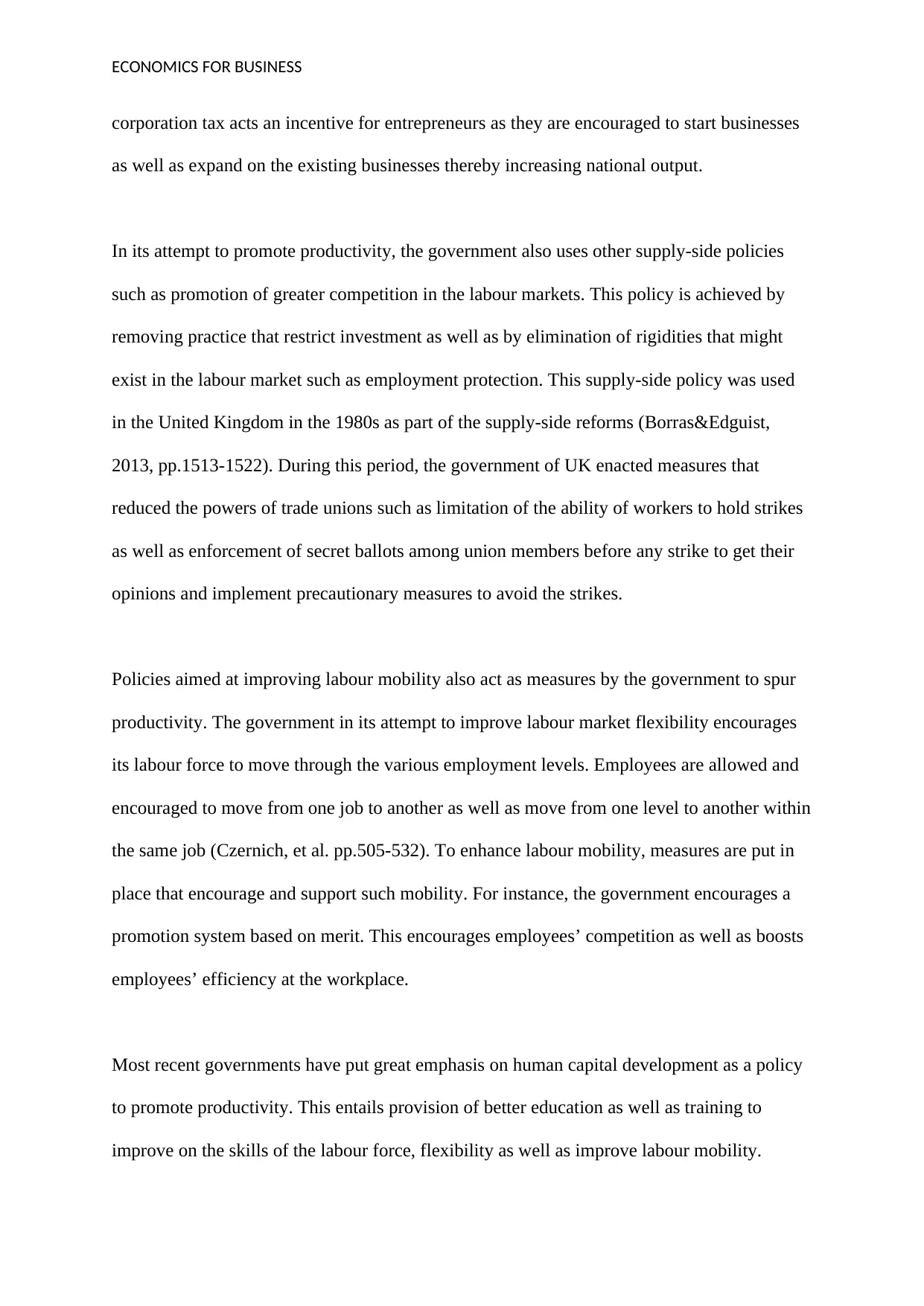
ECONOMICS FOR BUSINESS
corporation tax acts an incentive for entrepreneurs as they are encouraged to start businesses
as well as expand on the existing businesses thereby increasing national output.
In its attempt to promote productivity, the government also uses other supply-side policies
such as promotion of greater competition in the labour markets. This policy is achieved by
removing practice that restrict investment as well as by elimination of rigidities that might
exist in the labour market such as employment protection. This supply-side policy was used
in the United Kingdom in the 1980s as part of the supply-side reforms (Borras&Edguist,
2013, pp.1513-1522). During this period, the government of UK enacted measures that
reduced the powers of trade unions such as limitation of the ability of workers to hold strikes
as well as enforcement of secret ballots among union members before any strike to get their
opinions and implement precautionary measures to avoid the strikes.
Policies aimed at improving labour mobility also act as measures by the government to spur
productivity. The government in its attempt to improve labour market flexibility encourages
its labour force to move through the various employment levels. Employees are allowed and
encouraged to move from one job to another as well as move from one level to another within
the same job (Czernich, et al. pp.505-532). To enhance labour mobility, measures are put in
place that encourage and support such mobility. For instance, the government encourages a
promotion system based on merit. This encourages employees’ competition as well as boosts
employees’ efficiency at the workplace.
Most recent governments have put great emphasis on human capital development as a policy
to promote productivity. This entails provision of better education as well as training to
improve on the skills of the labour force, flexibility as well as improve labour mobility.
corporation tax acts an incentive for entrepreneurs as they are encouraged to start businesses
as well as expand on the existing businesses thereby increasing national output.
In its attempt to promote productivity, the government also uses other supply-side policies
such as promotion of greater competition in the labour markets. This policy is achieved by
removing practice that restrict investment as well as by elimination of rigidities that might
exist in the labour market such as employment protection. This supply-side policy was used
in the United Kingdom in the 1980s as part of the supply-side reforms (Borras&Edguist,
2013, pp.1513-1522). During this period, the government of UK enacted measures that
reduced the powers of trade unions such as limitation of the ability of workers to hold strikes
as well as enforcement of secret ballots among union members before any strike to get their
opinions and implement precautionary measures to avoid the strikes.
Policies aimed at improving labour mobility also act as measures by the government to spur
productivity. The government in its attempt to improve labour market flexibility encourages
its labour force to move through the various employment levels. Employees are allowed and
encouraged to move from one job to another as well as move from one level to another within
the same job (Czernich, et al. pp.505-532). To enhance labour mobility, measures are put in
place that encourage and support such mobility. For instance, the government encourages a
promotion system based on merit. This encourages employees’ competition as well as boosts
employees’ efficiency at the workplace.
Most recent governments have put great emphasis on human capital development as a policy
to promote productivity. This entails provision of better education as well as training to
improve on the skills of the labour force, flexibility as well as improve labour mobility.
⊘ This is a preview!⊘
Do you want full access?
Subscribe today to unlock all pages.

Trusted by 1+ million students worldwide
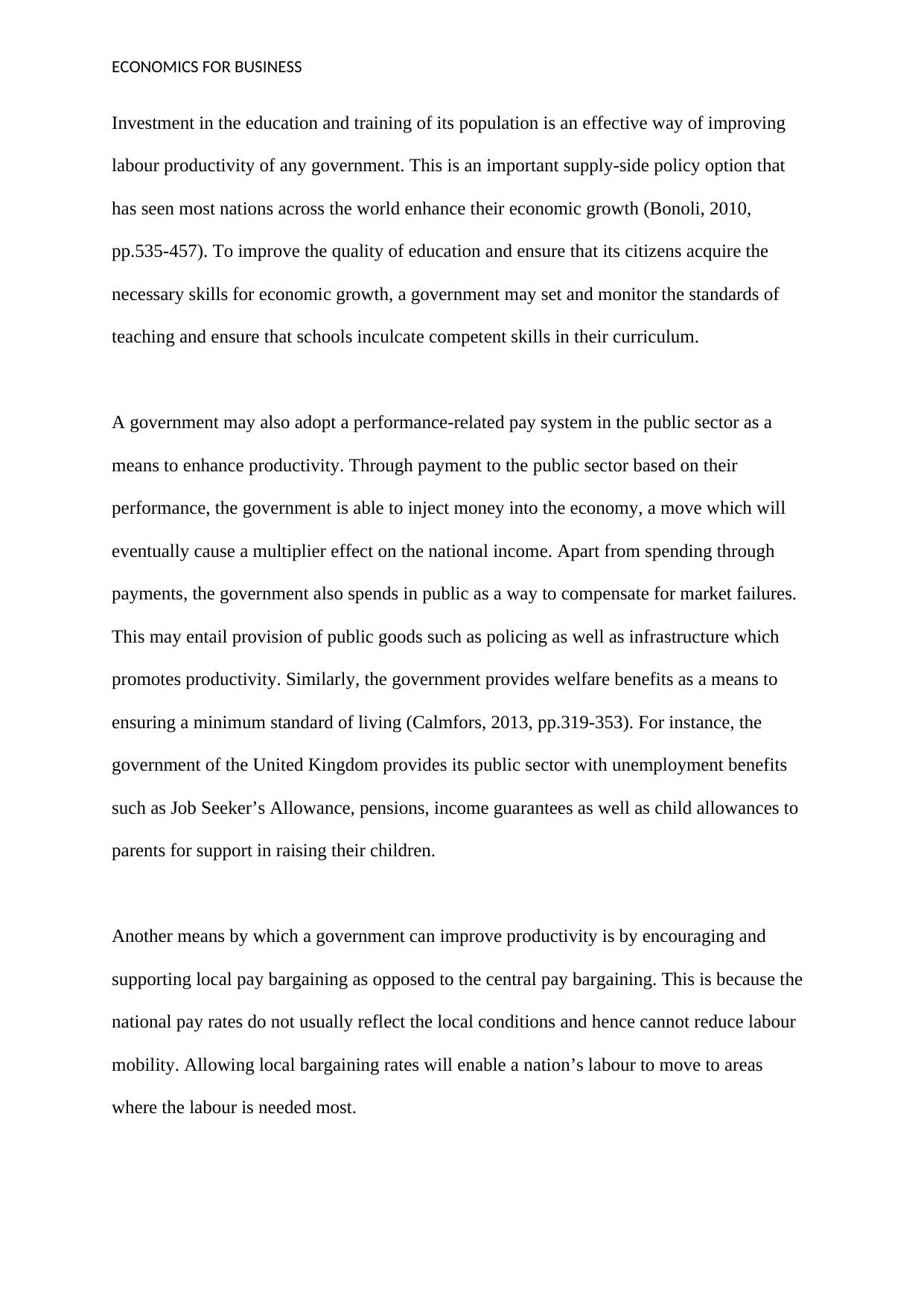
ECONOMICS FOR BUSINESS
Investment in the education and training of its population is an effective way of improving
labour productivity of any government. This is an important supply-side policy option that
has seen most nations across the world enhance their economic growth (Bonoli, 2010,
pp.535-457). To improve the quality of education and ensure that its citizens acquire the
necessary skills for economic growth, a government may set and monitor the standards of
teaching and ensure that schools inculcate competent skills in their curriculum.
A government may also adopt a performance-related pay system in the public sector as a
means to enhance productivity. Through payment to the public sector based on their
performance, the government is able to inject money into the economy, a move which will
eventually cause a multiplier effect on the national income. Apart from spending through
payments, the government also spends in public as a way to compensate for market failures.
This may entail provision of public goods such as policing as well as infrastructure which
promotes productivity. Similarly, the government provides welfare benefits as a means to
ensuring a minimum standard of living (Calmfors, 2013, pp.319-353). For instance, the
government of the United Kingdom provides its public sector with unemployment benefits
such as Job Seeker’s Allowance, pensions, income guarantees as well as child allowances to
parents for support in raising their children.
Another means by which a government can improve productivity is by encouraging and
supporting local pay bargaining as opposed to the central pay bargaining. This is because the
national pay rates do not usually reflect the local conditions and hence cannot reduce labour
mobility. Allowing local bargaining rates will enable a nation’s labour to move to areas
where the labour is needed most.
Investment in the education and training of its population is an effective way of improving
labour productivity of any government. This is an important supply-side policy option that
has seen most nations across the world enhance their economic growth (Bonoli, 2010,
pp.535-457). To improve the quality of education and ensure that its citizens acquire the
necessary skills for economic growth, a government may set and monitor the standards of
teaching and ensure that schools inculcate competent skills in their curriculum.
A government may also adopt a performance-related pay system in the public sector as a
means to enhance productivity. Through payment to the public sector based on their
performance, the government is able to inject money into the economy, a move which will
eventually cause a multiplier effect on the national income. Apart from spending through
payments, the government also spends in public as a way to compensate for market failures.
This may entail provision of public goods such as policing as well as infrastructure which
promotes productivity. Similarly, the government provides welfare benefits as a means to
ensuring a minimum standard of living (Calmfors, 2013, pp.319-353). For instance, the
government of the United Kingdom provides its public sector with unemployment benefits
such as Job Seeker’s Allowance, pensions, income guarantees as well as child allowances to
parents for support in raising their children.
Another means by which a government can improve productivity is by encouraging and
supporting local pay bargaining as opposed to the central pay bargaining. This is because the
national pay rates do not usually reflect the local conditions and hence cannot reduce labour
mobility. Allowing local bargaining rates will enable a nation’s labour to move to areas
where the labour is needed most.
Paraphrase This Document
Need a fresh take? Get an instant paraphrase of this document with our AI Paraphraser
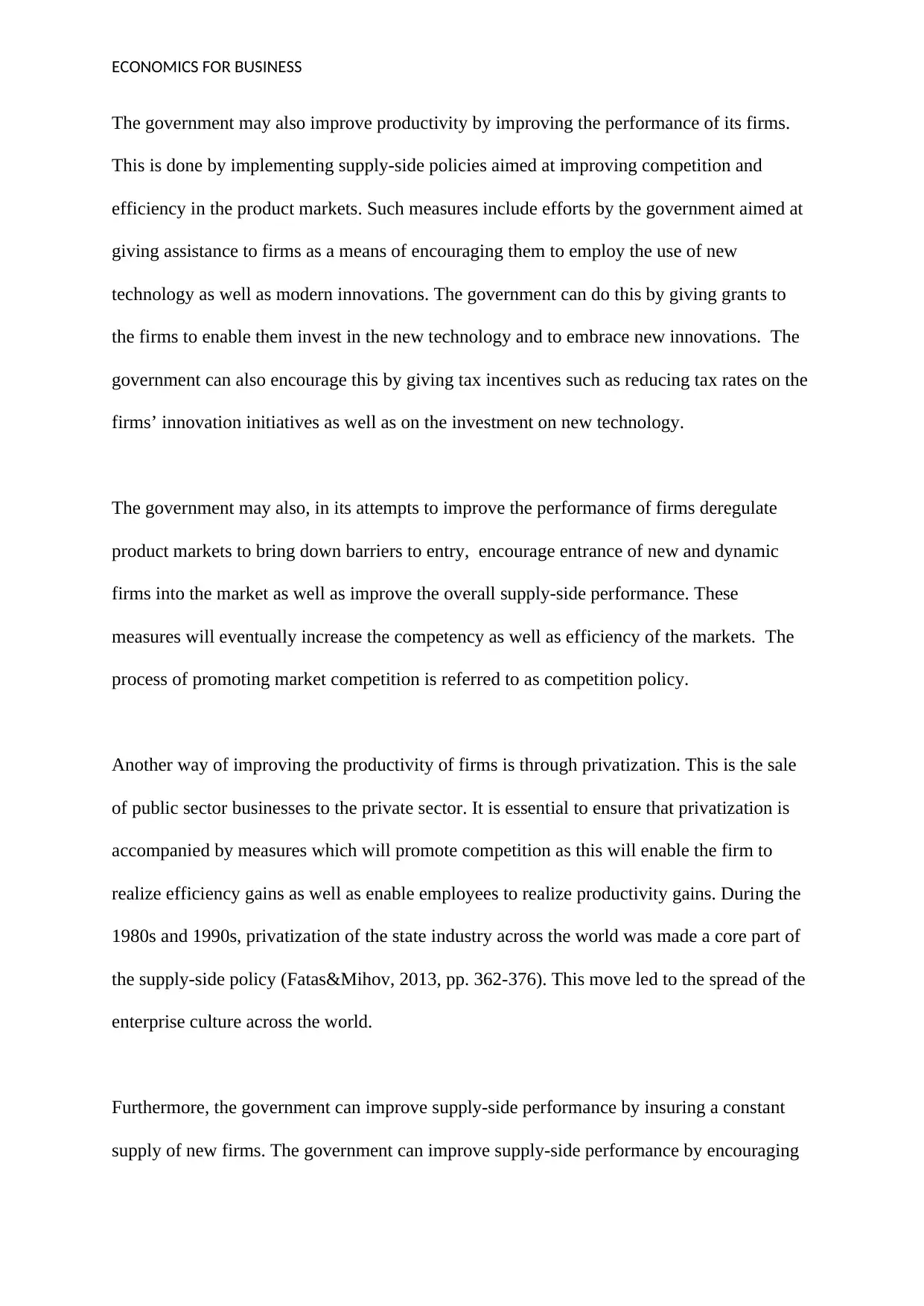
ECONOMICS FOR BUSINESS
The government may also improve productivity by improving the performance of its firms.
This is done by implementing supply-side policies aimed at improving competition and
efficiency in the product markets. Such measures include efforts by the government aimed at
giving assistance to firms as a means of encouraging them to employ the use of new
technology as well as modern innovations. The government can do this by giving grants to
the firms to enable them invest in the new technology and to embrace new innovations. The
government can also encourage this by giving tax incentives such as reducing tax rates on the
firms’ innovation initiatives as well as on the investment on new technology.
The government may also, in its attempts to improve the performance of firms deregulate
product markets to bring down barriers to entry, encourage entrance of new and dynamic
firms into the market as well as improve the overall supply-side performance. These
measures will eventually increase the competency as well as efficiency of the markets. The
process of promoting market competition is referred to as competition policy.
Another way of improving the productivity of firms is through privatization. This is the sale
of public sector businesses to the private sector. It is essential to ensure that privatization is
accompanied by measures which will promote competition as this will enable the firm to
realize efficiency gains as well as enable employees to realize productivity gains. During the
1980s and 1990s, privatization of the state industry across the world was made a core part of
the supply-side policy (Fatas&Mihov, 2013, pp. 362-376). This move led to the spread of the
enterprise culture across the world.
Furthermore, the government can improve supply-side performance by insuring a constant
supply of new firms. The government can improve supply-side performance by encouraging
The government may also improve productivity by improving the performance of its firms.
This is done by implementing supply-side policies aimed at improving competition and
efficiency in the product markets. Such measures include efforts by the government aimed at
giving assistance to firms as a means of encouraging them to employ the use of new
technology as well as modern innovations. The government can do this by giving grants to
the firms to enable them invest in the new technology and to embrace new innovations. The
government can also encourage this by giving tax incentives such as reducing tax rates on the
firms’ innovation initiatives as well as on the investment on new technology.
The government may also, in its attempts to improve the performance of firms deregulate
product markets to bring down barriers to entry, encourage entrance of new and dynamic
firms into the market as well as improve the overall supply-side performance. These
measures will eventually increase the competency as well as efficiency of the markets. The
process of promoting market competition is referred to as competition policy.
Another way of improving the productivity of firms is through privatization. This is the sale
of public sector businesses to the private sector. It is essential to ensure that privatization is
accompanied by measures which will promote competition as this will enable the firm to
realize efficiency gains as well as enable employees to realize productivity gains. During the
1980s and 1990s, privatization of the state industry across the world was made a core part of
the supply-side policy (Fatas&Mihov, 2013, pp. 362-376). This move led to the spread of the
enterprise culture across the world.
Furthermore, the government can improve supply-side performance by insuring a constant
supply of new firms. The government can improve supply-side performance by encouraging
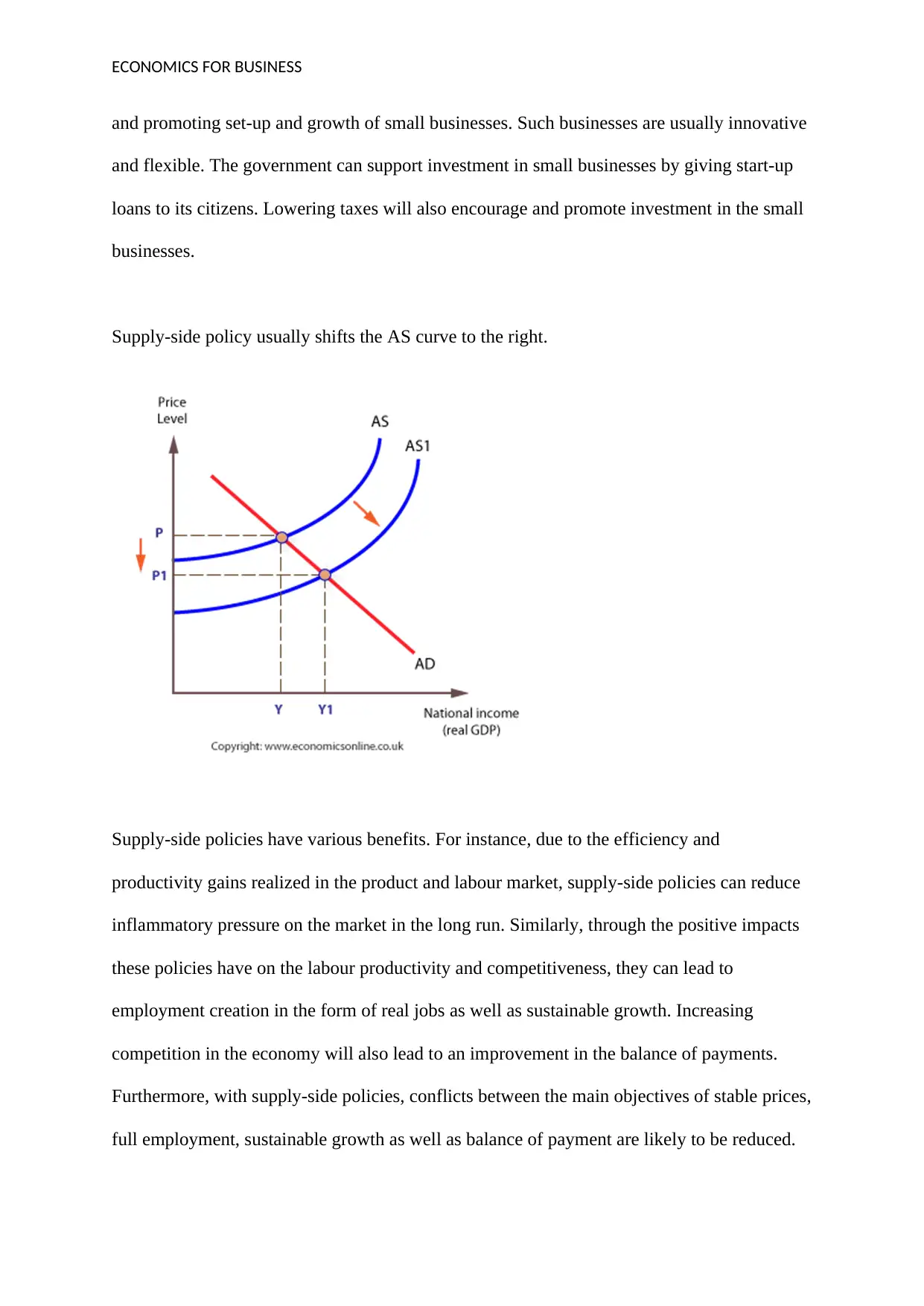
ECONOMICS FOR BUSINESS
and promoting set-up and growth of small businesses. Such businesses are usually innovative
and flexible. The government can support investment in small businesses by giving start-up
loans to its citizens. Lowering taxes will also encourage and promote investment in the small
businesses.
Supply-side policy usually shifts the AS curve to the right.
Supply-side policies have various benefits. For instance, due to the efficiency and
productivity gains realized in the product and labour market, supply-side policies can reduce
inflammatory pressure on the market in the long run. Similarly, through the positive impacts
these policies have on the labour productivity and competitiveness, they can lead to
employment creation in the form of real jobs as well as sustainable growth. Increasing
competition in the economy will also lead to an improvement in the balance of payments.
Furthermore, with supply-side policies, conflicts between the main objectives of stable prices,
full employment, sustainable growth as well as balance of payment are likely to be reduced.
and promoting set-up and growth of small businesses. Such businesses are usually innovative
and flexible. The government can support investment in small businesses by giving start-up
loans to its citizens. Lowering taxes will also encourage and promote investment in the small
businesses.
Supply-side policy usually shifts the AS curve to the right.
Supply-side policies have various benefits. For instance, due to the efficiency and
productivity gains realized in the product and labour market, supply-side policies can reduce
inflammatory pressure on the market in the long run. Similarly, through the positive impacts
these policies have on the labour productivity and competitiveness, they can lead to
employment creation in the form of real jobs as well as sustainable growth. Increasing
competition in the economy will also lead to an improvement in the balance of payments.
Furthermore, with supply-side policies, conflicts between the main objectives of stable prices,
full employment, sustainable growth as well as balance of payment are likely to be reduced.
⊘ This is a preview!⊘
Do you want full access?
Subscribe today to unlock all pages.

Trusted by 1+ million students worldwide
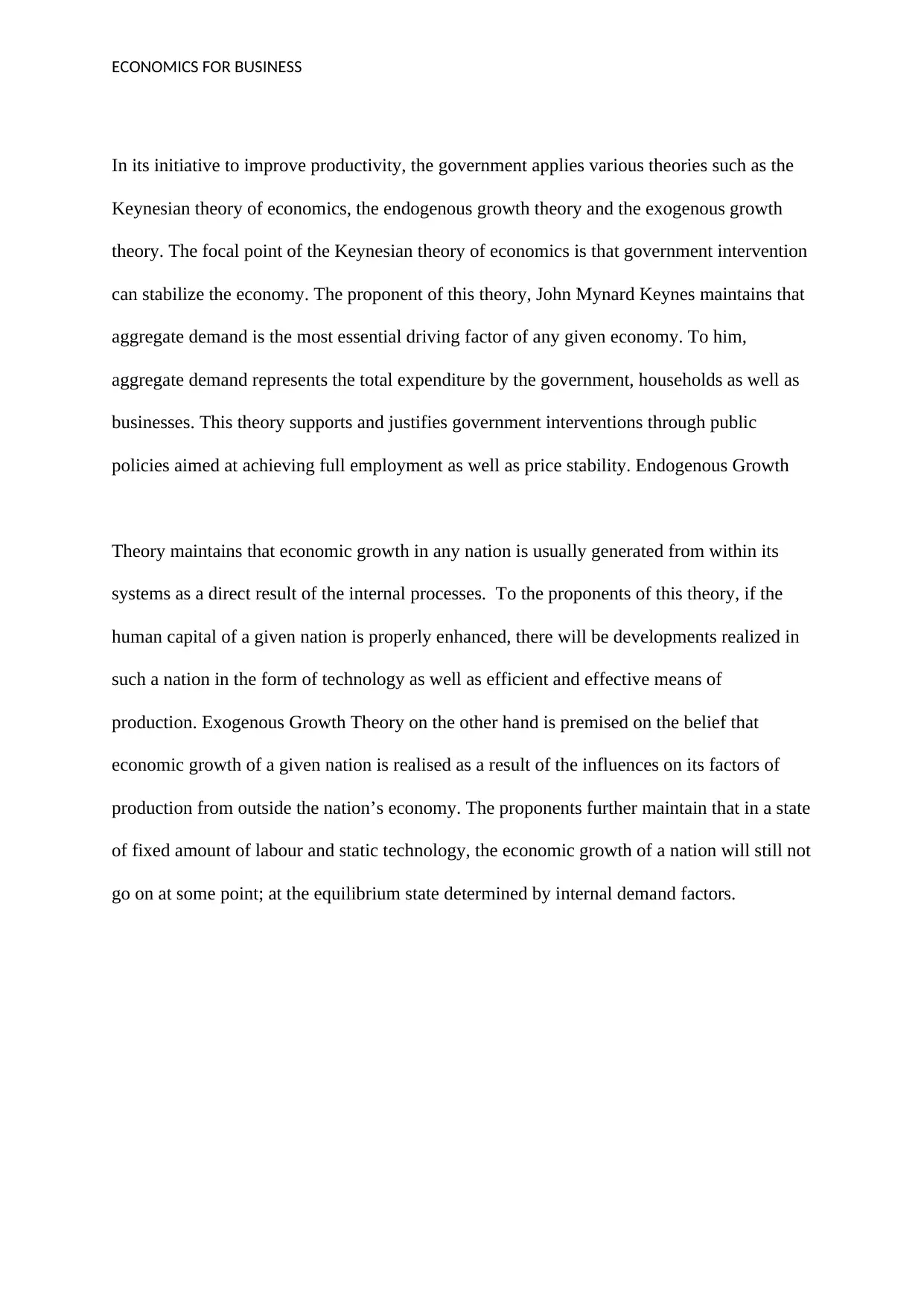
ECONOMICS FOR BUSINESS
In its initiative to improve productivity, the government applies various theories such as the
Keynesian theory of economics, the endogenous growth theory and the exogenous growth
theory. The focal point of the Keynesian theory of economics is that government intervention
can stabilize the economy. The proponent of this theory, John Mynard Keynes maintains that
aggregate demand is the most essential driving factor of any given economy. To him,
aggregate demand represents the total expenditure by the government, households as well as
businesses. This theory supports and justifies government interventions through public
policies aimed at achieving full employment as well as price stability. Endogenous Growth
Theory maintains that economic growth in any nation is usually generated from within its
systems as a direct result of the internal processes. To the proponents of this theory, if the
human capital of a given nation is properly enhanced, there will be developments realized in
such a nation in the form of technology as well as efficient and effective means of
production. Exogenous Growth Theory on the other hand is premised on the belief that
economic growth of a given nation is realised as a result of the influences on its factors of
production from outside the nation’s economy. The proponents further maintain that in a state
of fixed amount of labour and static technology, the economic growth of a nation will still not
go on at some point; at the equilibrium state determined by internal demand factors.
In its initiative to improve productivity, the government applies various theories such as the
Keynesian theory of economics, the endogenous growth theory and the exogenous growth
theory. The focal point of the Keynesian theory of economics is that government intervention
can stabilize the economy. The proponent of this theory, John Mynard Keynes maintains that
aggregate demand is the most essential driving factor of any given economy. To him,
aggregate demand represents the total expenditure by the government, households as well as
businesses. This theory supports and justifies government interventions through public
policies aimed at achieving full employment as well as price stability. Endogenous Growth
Theory maintains that economic growth in any nation is usually generated from within its
systems as a direct result of the internal processes. To the proponents of this theory, if the
human capital of a given nation is properly enhanced, there will be developments realized in
such a nation in the form of technology as well as efficient and effective means of
production. Exogenous Growth Theory on the other hand is premised on the belief that
economic growth of a given nation is realised as a result of the influences on its factors of
production from outside the nation’s economy. The proponents further maintain that in a state
of fixed amount of labour and static technology, the economic growth of a nation will still not
go on at some point; at the equilibrium state determined by internal demand factors.
Paraphrase This Document
Need a fresh take? Get an instant paraphrase of this document with our AI Paraphraser
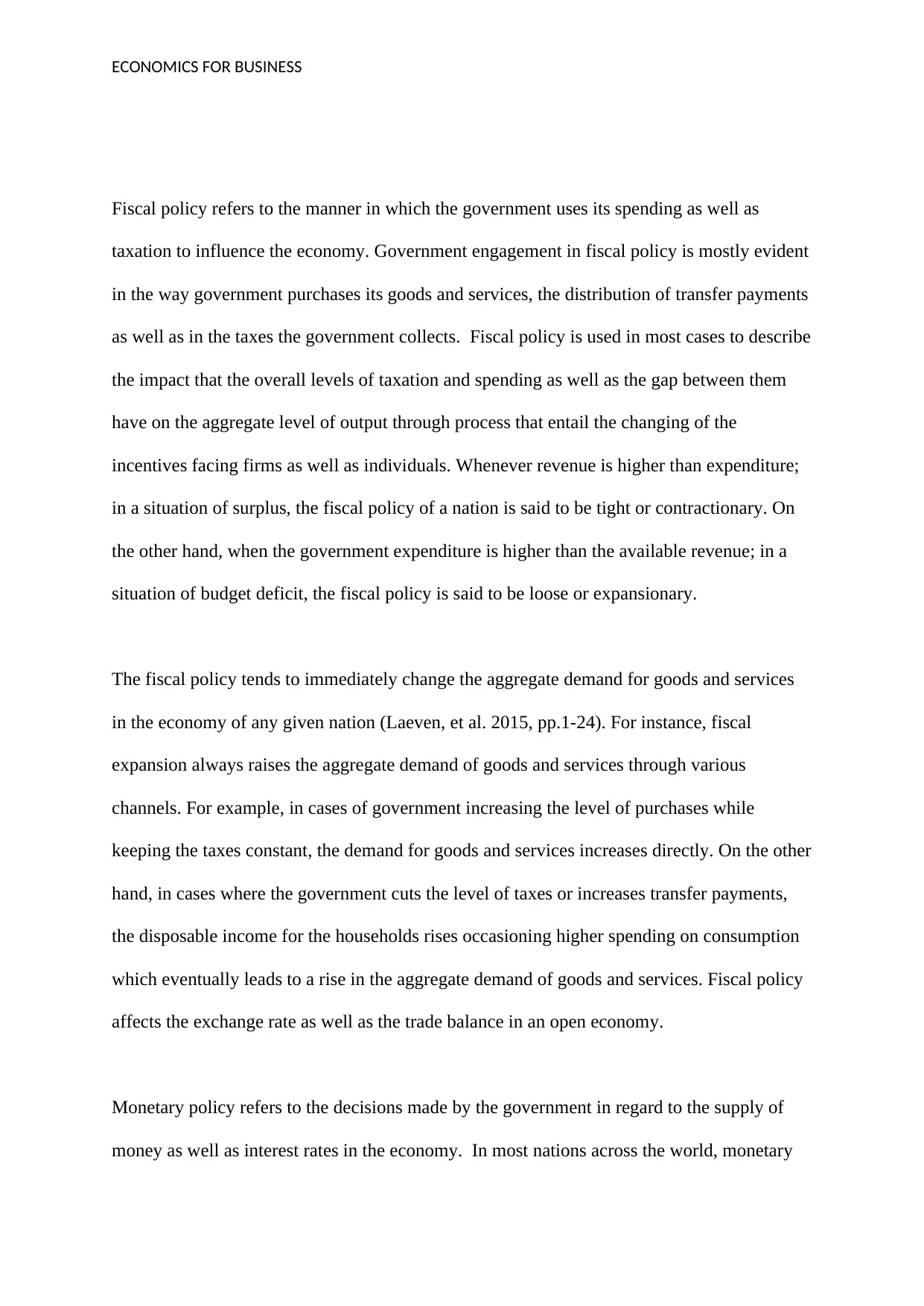
ECONOMICS FOR BUSINESS
Fiscal policy refers to the manner in which the government uses its spending as well as
taxation to influence the economy. Government engagement in fiscal policy is mostly evident
in the way government purchases its goods and services, the distribution of transfer payments
as well as in the taxes the government collects. Fiscal policy is used in most cases to describe
the impact that the overall levels of taxation and spending as well as the gap between them
have on the aggregate level of output through process that entail the changing of the
incentives facing firms as well as individuals. Whenever revenue is higher than expenditure;
in a situation of surplus, the fiscal policy of a nation is said to be tight or contractionary. On
the other hand, when the government expenditure is higher than the available revenue; in a
situation of budget deficit, the fiscal policy is said to be loose or expansionary.
The fiscal policy tends to immediately change the aggregate demand for goods and services
in the economy of any given nation (Laeven, et al. 2015, pp.1-24). For instance, fiscal
expansion always raises the aggregate demand of goods and services through various
channels. For example, in cases of government increasing the level of purchases while
keeping the taxes constant, the demand for goods and services increases directly. On the other
hand, in cases where the government cuts the level of taxes or increases transfer payments,
the disposable income for the households rises occasioning higher spending on consumption
which eventually leads to a rise in the aggregate demand of goods and services. Fiscal policy
affects the exchange rate as well as the trade balance in an open economy.
Monetary policy refers to the decisions made by the government in regard to the supply of
money as well as interest rates in the economy. In most nations across the world, monetary
Fiscal policy refers to the manner in which the government uses its spending as well as
taxation to influence the economy. Government engagement in fiscal policy is mostly evident
in the way government purchases its goods and services, the distribution of transfer payments
as well as in the taxes the government collects. Fiscal policy is used in most cases to describe
the impact that the overall levels of taxation and spending as well as the gap between them
have on the aggregate level of output through process that entail the changing of the
incentives facing firms as well as individuals. Whenever revenue is higher than expenditure;
in a situation of surplus, the fiscal policy of a nation is said to be tight or contractionary. On
the other hand, when the government expenditure is higher than the available revenue; in a
situation of budget deficit, the fiscal policy is said to be loose or expansionary.
The fiscal policy tends to immediately change the aggregate demand for goods and services
in the economy of any given nation (Laeven, et al. 2015, pp.1-24). For instance, fiscal
expansion always raises the aggregate demand of goods and services through various
channels. For example, in cases of government increasing the level of purchases while
keeping the taxes constant, the demand for goods and services increases directly. On the other
hand, in cases where the government cuts the level of taxes or increases transfer payments,
the disposable income for the households rises occasioning higher spending on consumption
which eventually leads to a rise in the aggregate demand of goods and services. Fiscal policy
affects the exchange rate as well as the trade balance in an open economy.
Monetary policy refers to the decisions made by the government in regard to the supply of
money as well as interest rates in the economy. In most nations across the world, monetary
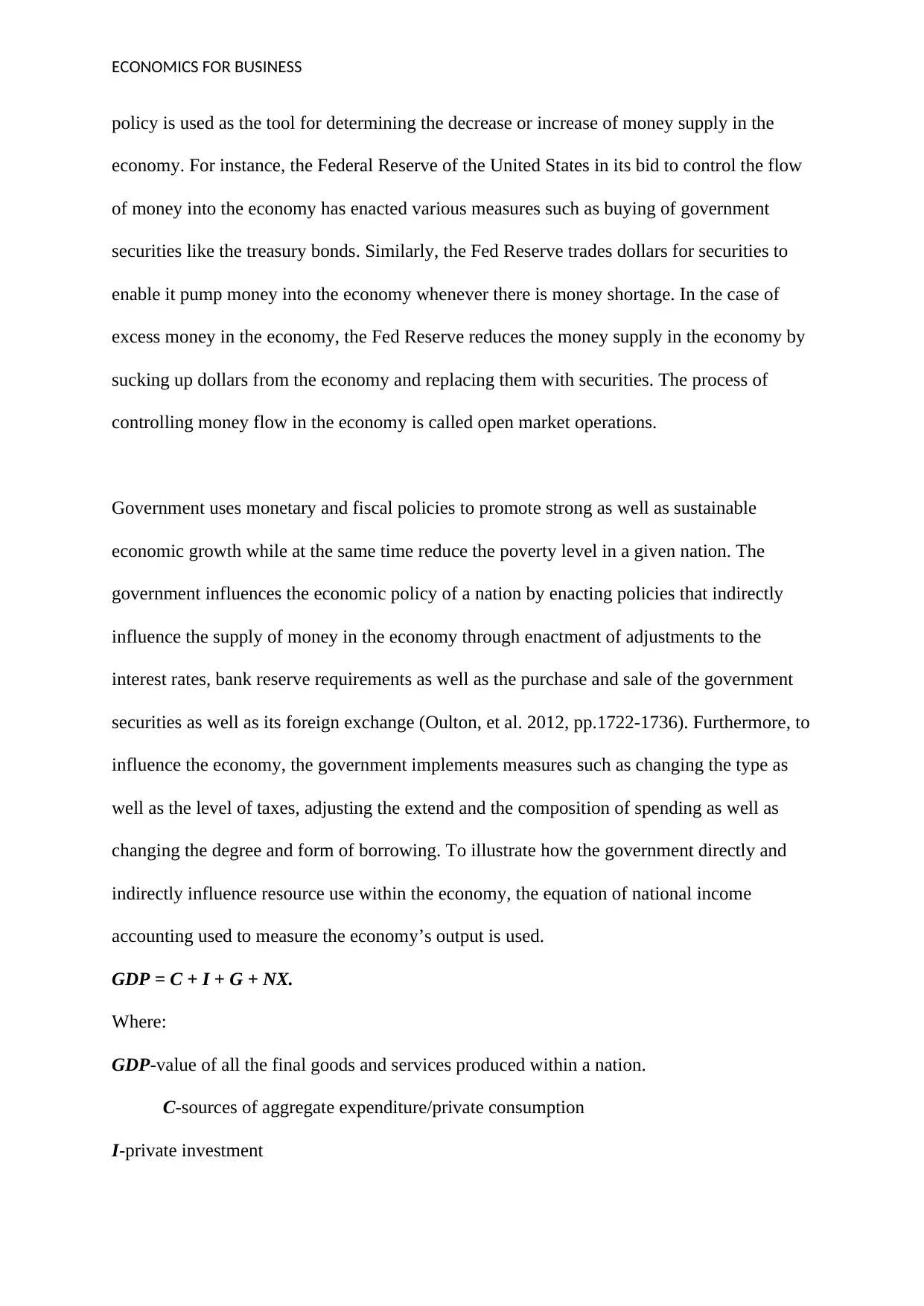
ECONOMICS FOR BUSINESS
policy is used as the tool for determining the decrease or increase of money supply in the
economy. For instance, the Federal Reserve of the United States in its bid to control the flow
of money into the economy has enacted various measures such as buying of government
securities like the treasury bonds. Similarly, the Fed Reserve trades dollars for securities to
enable it pump money into the economy whenever there is money shortage. In the case of
excess money in the economy, the Fed Reserve reduces the money supply in the economy by
sucking up dollars from the economy and replacing them with securities. The process of
controlling money flow in the economy is called open market operations.
Government uses monetary and fiscal policies to promote strong as well as sustainable
economic growth while at the same time reduce the poverty level in a given nation. The
government influences the economic policy of a nation by enacting policies that indirectly
influence the supply of money in the economy through enactment of adjustments to the
interest rates, bank reserve requirements as well as the purchase and sale of the government
securities as well as its foreign exchange (Oulton, et al. 2012, pp.1722-1736). Furthermore, to
influence the economy, the government implements measures such as changing the type as
well as the level of taxes, adjusting the extend and the composition of spending as well as
changing the degree and form of borrowing. To illustrate how the government directly and
indirectly influence resource use within the economy, the equation of national income
accounting used to measure the economy’s output is used.
GDP = C + I + G + NX.
Where:
GDP-value of all the final goods and services produced within a nation.
C-sources of aggregate expenditure/private consumption
I-private investment
policy is used as the tool for determining the decrease or increase of money supply in the
economy. For instance, the Federal Reserve of the United States in its bid to control the flow
of money into the economy has enacted various measures such as buying of government
securities like the treasury bonds. Similarly, the Fed Reserve trades dollars for securities to
enable it pump money into the economy whenever there is money shortage. In the case of
excess money in the economy, the Fed Reserve reduces the money supply in the economy by
sucking up dollars from the economy and replacing them with securities. The process of
controlling money flow in the economy is called open market operations.
Government uses monetary and fiscal policies to promote strong as well as sustainable
economic growth while at the same time reduce the poverty level in a given nation. The
government influences the economic policy of a nation by enacting policies that indirectly
influence the supply of money in the economy through enactment of adjustments to the
interest rates, bank reserve requirements as well as the purchase and sale of the government
securities as well as its foreign exchange (Oulton, et al. 2012, pp.1722-1736). Furthermore, to
influence the economy, the government implements measures such as changing the type as
well as the level of taxes, adjusting the extend and the composition of spending as well as
changing the degree and form of borrowing. To illustrate how the government directly and
indirectly influence resource use within the economy, the equation of national income
accounting used to measure the economy’s output is used.
GDP = C + I + G + NX.
Where:
GDP-value of all the final goods and services produced within a nation.
C-sources of aggregate expenditure/private consumption
I-private investment
⊘ This is a preview!⊘
Do you want full access?
Subscribe today to unlock all pages.

Trusted by 1+ million students worldwide
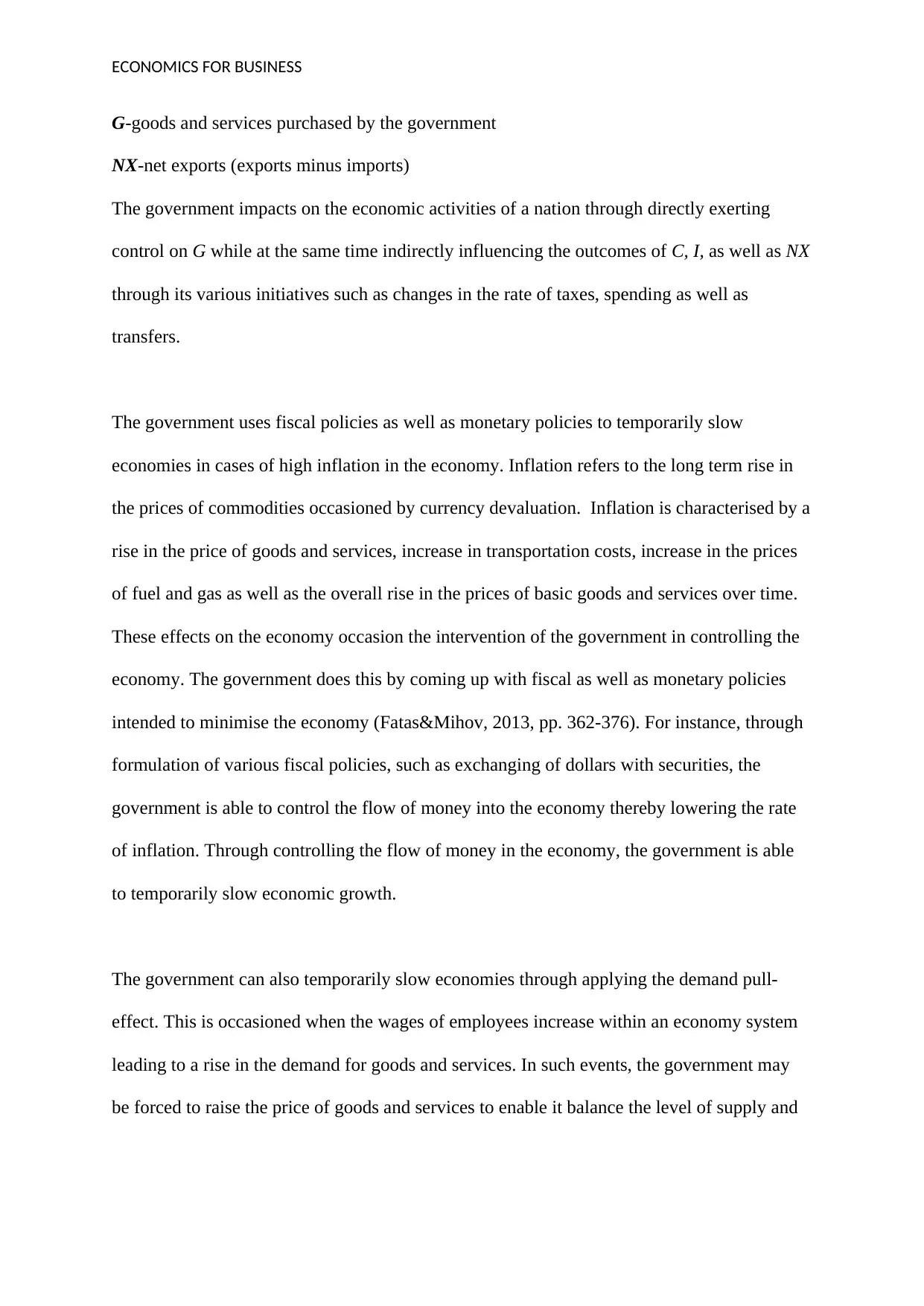
ECONOMICS FOR BUSINESS
G-goods and services purchased by the government
NX-net exports (exports minus imports)
The government impacts on the economic activities of a nation through directly exerting
control on G while at the same time indirectly influencing the outcomes of C, I, as well as NX
through its various initiatives such as changes in the rate of taxes, spending as well as
transfers.
The government uses fiscal policies as well as monetary policies to temporarily slow
economies in cases of high inflation in the economy. Inflation refers to the long term rise in
the prices of commodities occasioned by currency devaluation. Inflation is characterised by a
rise in the price of goods and services, increase in transportation costs, increase in the prices
of fuel and gas as well as the overall rise in the prices of basic goods and services over time.
These effects on the economy occasion the intervention of the government in controlling the
economy. The government does this by coming up with fiscal as well as monetary policies
intended to minimise the economy (Fatas&Mihov, 2013, pp. 362-376). For instance, through
formulation of various fiscal policies, such as exchanging of dollars with securities, the
government is able to control the flow of money into the economy thereby lowering the rate
of inflation. Through controlling the flow of money in the economy, the government is able
to temporarily slow economic growth.
The government can also temporarily slow economies through applying the demand pull-
effect. This is occasioned when the wages of employees increase within an economy system
leading to a rise in the demand for goods and services. In such events, the government may
be forced to raise the price of goods and services to enable it balance the level of supply and
G-goods and services purchased by the government
NX-net exports (exports minus imports)
The government impacts on the economic activities of a nation through directly exerting
control on G while at the same time indirectly influencing the outcomes of C, I, as well as NX
through its various initiatives such as changes in the rate of taxes, spending as well as
transfers.
The government uses fiscal policies as well as monetary policies to temporarily slow
economies in cases of high inflation in the economy. Inflation refers to the long term rise in
the prices of commodities occasioned by currency devaluation. Inflation is characterised by a
rise in the price of goods and services, increase in transportation costs, increase in the prices
of fuel and gas as well as the overall rise in the prices of basic goods and services over time.
These effects on the economy occasion the intervention of the government in controlling the
economy. The government does this by coming up with fiscal as well as monetary policies
intended to minimise the economy (Fatas&Mihov, 2013, pp. 362-376). For instance, through
formulation of various fiscal policies, such as exchanging of dollars with securities, the
government is able to control the flow of money into the economy thereby lowering the rate
of inflation. Through controlling the flow of money in the economy, the government is able
to temporarily slow economic growth.
The government can also temporarily slow economies through applying the demand pull-
effect. This is occasioned when the wages of employees increase within an economy system
leading to a rise in the demand for goods and services. In such events, the government may
be forced to raise the price of goods and services to enable it balance the level of supply and
Paraphrase This Document
Need a fresh take? Get an instant paraphrase of this document with our AI Paraphraser
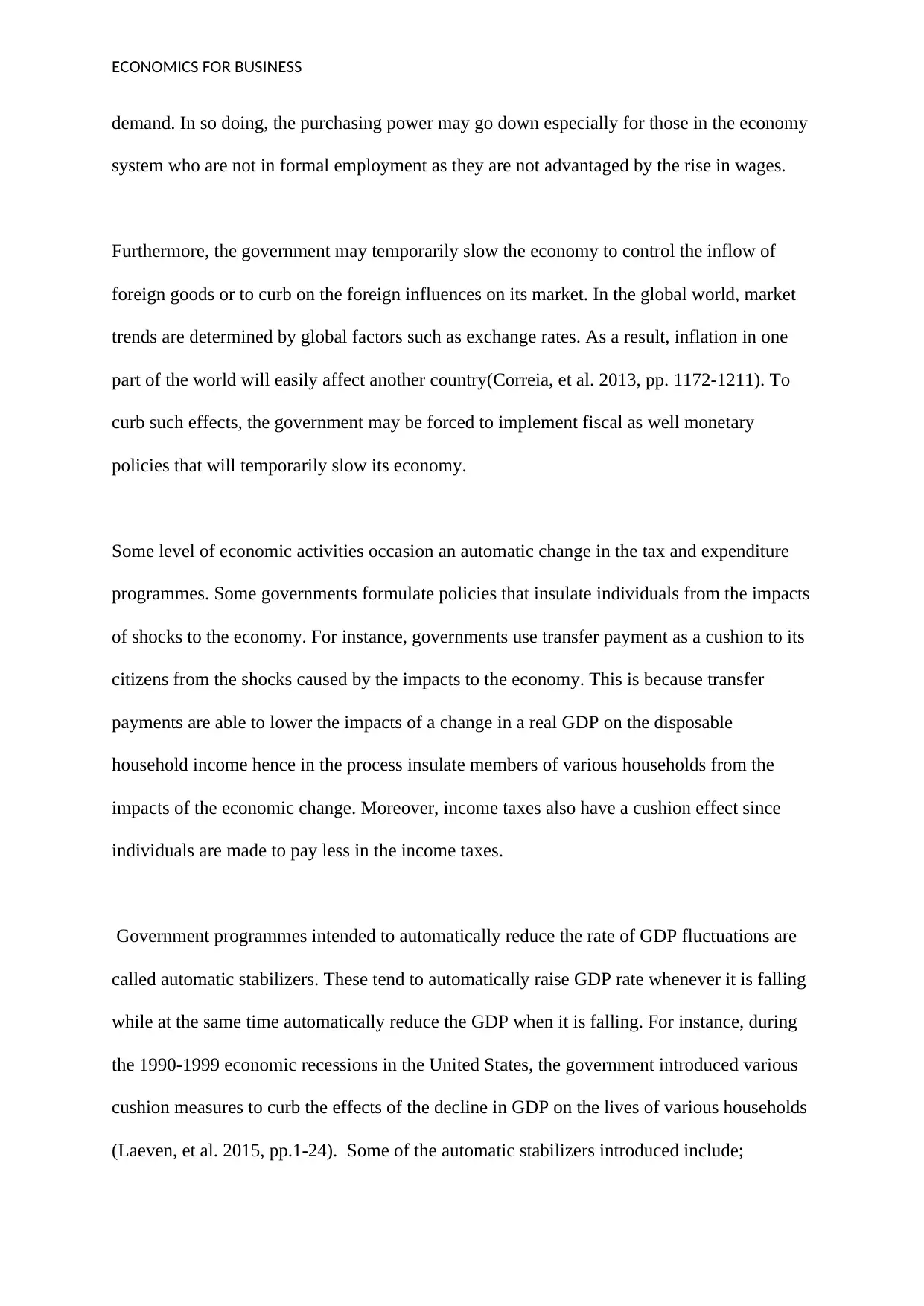
ECONOMICS FOR BUSINESS
demand. In so doing, the purchasing power may go down especially for those in the economy
system who are not in formal employment as they are not advantaged by the rise in wages.
Furthermore, the government may temporarily slow the economy to control the inflow of
foreign goods or to curb on the foreign influences on its market. In the global world, market
trends are determined by global factors such as exchange rates. As a result, inflation in one
part of the world will easily affect another country(Correia, et al. 2013, pp. 1172-1211). To
curb such effects, the government may be forced to implement fiscal as well monetary
policies that will temporarily slow its economy.
Some level of economic activities occasion an automatic change in the tax and expenditure
programmes. Some governments formulate policies that insulate individuals from the impacts
of shocks to the economy. For instance, governments use transfer payment as a cushion to its
citizens from the shocks caused by the impacts to the economy. This is because transfer
payments are able to lower the impacts of a change in a real GDP on the disposable
household income hence in the process insulate members of various households from the
impacts of the economic change. Moreover, income taxes also have a cushion effect since
individuals are made to pay less in the income taxes.
Government programmes intended to automatically reduce the rate of GDP fluctuations are
called automatic stabilizers. These tend to automatically raise GDP rate whenever it is falling
while at the same time automatically reduce the GDP when it is falling. For instance, during
the 1990-1999 economic recessions in the United States, the government introduced various
cushion measures to curb the effects of the decline in GDP on the lives of various households
(Laeven, et al. 2015, pp.1-24). Some of the automatic stabilizers introduced include;
demand. In so doing, the purchasing power may go down especially for those in the economy
system who are not in formal employment as they are not advantaged by the rise in wages.
Furthermore, the government may temporarily slow the economy to control the inflow of
foreign goods or to curb on the foreign influences on its market. In the global world, market
trends are determined by global factors such as exchange rates. As a result, inflation in one
part of the world will easily affect another country(Correia, et al. 2013, pp. 1172-1211). To
curb such effects, the government may be forced to implement fiscal as well monetary
policies that will temporarily slow its economy.
Some level of economic activities occasion an automatic change in the tax and expenditure
programmes. Some governments formulate policies that insulate individuals from the impacts
of shocks to the economy. For instance, governments use transfer payment as a cushion to its
citizens from the shocks caused by the impacts to the economy. This is because transfer
payments are able to lower the impacts of a change in a real GDP on the disposable
household income hence in the process insulate members of various households from the
impacts of the economic change. Moreover, income taxes also have a cushion effect since
individuals are made to pay less in the income taxes.
Government programmes intended to automatically reduce the rate of GDP fluctuations are
called automatic stabilizers. These tend to automatically raise GDP rate whenever it is falling
while at the same time automatically reduce the GDP when it is falling. For instance, during
the 1990-1999 economic recessions in the United States, the government introduced various
cushion measures to curb the effects of the decline in GDP on the lives of various households
(Laeven, et al. 2015, pp.1-24). Some of the automatic stabilizers introduced include;
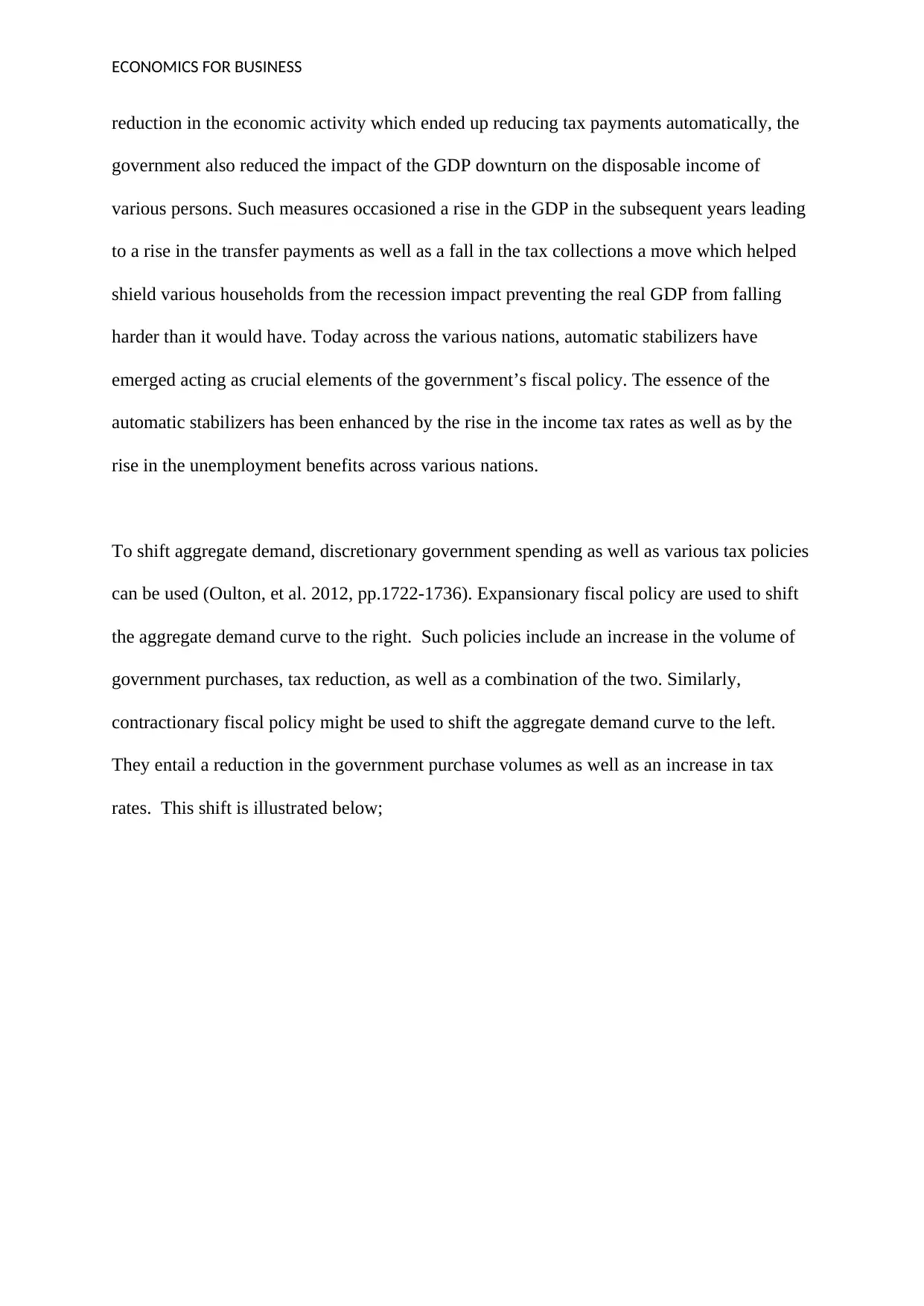
ECONOMICS FOR BUSINESS
reduction in the economic activity which ended up reducing tax payments automatically, the
government also reduced the impact of the GDP downturn on the disposable income of
various persons. Such measures occasioned a rise in the GDP in the subsequent years leading
to a rise in the transfer payments as well as a fall in the tax collections a move which helped
shield various households from the recession impact preventing the real GDP from falling
harder than it would have. Today across the various nations, automatic stabilizers have
emerged acting as crucial elements of the government’s fiscal policy. The essence of the
automatic stabilizers has been enhanced by the rise in the income tax rates as well as by the
rise in the unemployment benefits across various nations.
To shift aggregate demand, discretionary government spending as well as various tax policies
can be used (Oulton, et al. 2012, pp.1722-1736). Expansionary fiscal policy are used to shift
the aggregate demand curve to the right. Such policies include an increase in the volume of
government purchases, tax reduction, as well as a combination of the two. Similarly,
contractionary fiscal policy might be used to shift the aggregate demand curve to the left.
They entail a reduction in the government purchase volumes as well as an increase in tax
rates. This shift is illustrated below;
reduction in the economic activity which ended up reducing tax payments automatically, the
government also reduced the impact of the GDP downturn on the disposable income of
various persons. Such measures occasioned a rise in the GDP in the subsequent years leading
to a rise in the transfer payments as well as a fall in the tax collections a move which helped
shield various households from the recession impact preventing the real GDP from falling
harder than it would have. Today across the various nations, automatic stabilizers have
emerged acting as crucial elements of the government’s fiscal policy. The essence of the
automatic stabilizers has been enhanced by the rise in the income tax rates as well as by the
rise in the unemployment benefits across various nations.
To shift aggregate demand, discretionary government spending as well as various tax policies
can be used (Oulton, et al. 2012, pp.1722-1736). Expansionary fiscal policy are used to shift
the aggregate demand curve to the right. Such policies include an increase in the volume of
government purchases, tax reduction, as well as a combination of the two. Similarly,
contractionary fiscal policy might be used to shift the aggregate demand curve to the left.
They entail a reduction in the government purchase volumes as well as an increase in tax
rates. This shift is illustrated below;
⊘ This is a preview!⊘
Do you want full access?
Subscribe today to unlock all pages.

Trusted by 1+ million students worldwide
1 out of 15
Related Documents
Your All-in-One AI-Powered Toolkit for Academic Success.
+13062052269
info@desklib.com
Available 24*7 on WhatsApp / Email
![[object Object]](/_next/static/media/star-bottom.7253800d.svg)
Unlock your academic potential
Copyright © 2020–2025 A2Z Services. All Rights Reserved. Developed and managed by ZUCOL.





